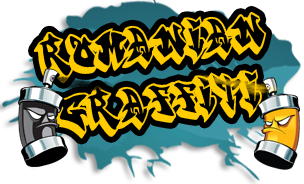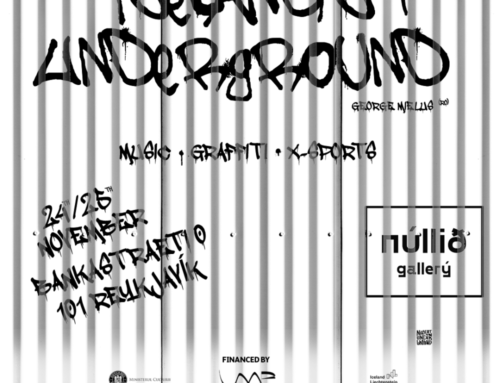Tagging: changing visual patterns and the rhetorical implications of a new form of graffiti
By Daniel D. Gross & Timothy D. Gross. Full text is © International Society for General Semantics, 1993, „Words of the prophets-written on the subway walls”
According to Michel Foucault, written language pictures mental images, thus capturing the otherwise fleeting experience known as spoken language. In other words, written language depicts visibly both impressions and oral utterances, the byproduct of which is a repository for reflection. Reflection upon this visible repository may reveal clues into a people’s cultural experience and even their way of knowing (Foucault, 1970).
Some written forms of language reflect the accepted conventions more than others. For example, the words on this page reflect the standard, formal, English vernacular used in scholarly writing. On the other hand, some forms of writing may express the non-standard or perhaps, the common vernacular – graffiti, for example. Whatever the form, written expressions change. While it is possible to note the changes from written Shakespearean English to the English of today, it is also possible to note the changes that have occurred in the non-formal arena of written language. This paper traces the most obvious changes that have occurred in a non-formal aspect of writing called „graffiti.” We trace its origin from the earliest recorded incidents until the present with special emphasis given the most recent expression of graffiti – „tagging.”
The word „graffiti”, borrowed from the Italian, refers to crude drawings or inscriptions scratched or drawn on a wall or other surface and intended to be viewed by the public. This general definition emphasizes three important aspects of graffiti – place, style, and purpose.
A myriad of forces have influenced the changes that have occurred in the visible form of graffiti throughout the centuries. These changes, plus the notion that graffiti has a rhetorical purpose, suggest fertile ground for interpretation. However, the focus of this paper is primarily descriptive with an emphasis on the changing visual patterns of graffiti and their possible implications.
Data used in this study were collected from a variety of sources, including books and bathroom walls. Some of the material was collected by camera or by the freehand copy of Timothy D. Gross (1992). Though photographs of all the data were preferred, at times freehand copies were necessary because of the sheer danger of the environment in which the graffiti samples were located.
Following data collection, a form of cluster analysis (Burke, 1973, 20) supported by grounded theory (Glaser and Strauss, 1967) was utilized to analyze the data which was spread along a broad historical time line. Grounded theory provided the framework for the data to suggest its own natural categories, while cluster analysis provided a method for later interpretation.
Cluster analysis revealed three phases of visible form in the historical development of graffiti: the imitative phase, the transition phase, and the most recent, the apocryphal phase.
Plato claims that written language is primarily an imitative response (Preminger, 1975, 65). In other words, written symbols found on a page are imitating the sounds of oral speech. In like manner earliest forms of graffiti were imitations of perceived objects; for example, a prehistoric cave dweller might draw the likeness of buffalo or birds on the walls of a cave. The drawings, though crude by some standards, imitated the world as seen by early humans.
For thousands of years mimicking the perceived physical world dominated the early historical or perhaps prehistoric phase of graffiti. In this phase, drawings on the walls imitate world perceived.
Literally millennia transpired before the next major phase of graffiti appeared on the walls of civilization. This phase required the advent of „letters” which represented oral sounds. Though imitation is still the impetus, as claimed by Plato regarding all writing, the transition phase of graffiti’s historical development added letters/words to the drawings on the walls. Thus the transition phase represents a movement from symbols imitating only visible objects to symbols representing sounds as well. This phase marks the combining of two categories of symbols on the walls. However, during the earlier years, visual symbols dominated, with words dominating in the later years of the transition phase.
The movement of graffiti from visible symbol to word symbol occurred in three broad strokes covering approximately 2500 years. The first stroke includes graffiti that is primarily a social expression. The second stroke is primarily a personal expression and the third primarily a word-message expression.
With this stroke of the transition phase, graffiti’s dominant characteristics are marked by drawings accompanied by a few letters or words. The graphic illustration of the hatred and contempt sometimes evoked by the Christian faith. The graffiti was found in 1856 in one of the guardrooms of the Palatine in Rome, the site of the imperial palace. The graffiti was scratched on the wall in the first hall of the third century A. D. and shows a man kneeling to a crucified figure with an ass’s head. The inscription states that here is „Alexamenos worshipping his god.” The allusion to Christianity is evident; similar calumnies regarding the worship of an ass had already been uttered by the enemies of the Jews in the hellenistic period (source unknown).
Though the graffiti was most likely the product of a single individual, the content is social in nature. The drawing signifies a reaction of one social group’s perception against another’s. Thus the graffiti represents a stroke within the transition phase called a „social-expressive,” form combining drawings and letters/words with an emphasis on drawing.
Within this stroke of the transition phase, graffiti’s dominant characteristics are marked by drawings accompanied by words, not unlike the former stroke but with the added distinction that the graffiti was clearly the product of an individual representing a personal state of affairs.
Few people over forty have difficulty recalling graffiti. In fact, in most small towns such graffiti expressions are still common. The drawing is most likely the product of individuals expressing their own personal feelings for another or perhaps the expression of an individual’s wishes. Nonetheless, the graffiti represents a stroke within the transition phase called a „personal-expressive,” form combining, like the social-expressive stroke, drawings and letters/words with a possible emphasis on word. The major difference in this stroke and the previous one involves a movement toward the use of words over drawings and personal expression rather than social expression.
Within this third stroke of the transition phase, graffiti’s dominant characteristic is the transition away from drawings altogether to words. Though the focus of this paper has been visible form, content does enter the process of distinguishing the form of this stroke of the transition phase to a small degree, for in this stroke words dominate but the words are also part of clearly distinguished messages. The most obvious characteristic of these messages is that they are mediated by words not drawings; three word-message examples follow: (1) Jesus saves … Moses invests (2) God is dead – Signed Nietzche (3) Nietzche is dead – Signed God (4) God is dead But don’t worry, Mary’s pregnant again (Abel, 1977, 121-2).
The word-message expression, which characterizes this final stroke, brings the transition phase to completion. With its concluding development it leaves „words” as the dominant visual form instead of drawings or some combination of words and drawings. This fact is crucial for understanding the next major phase of graffiti from a historical perspective focusing on visual form.
Within the last 25 years a new form of graffiti has appeared on the walls. The name most often used to designate this new visual form is „tagging” (Lachmann, 1988; Raymond, 1989). The dominant visual impression of this phase includes words, though the graffiti only leaves a hint of words. The graffiti depicts words in disguise, thus the label apocryphal. The words both reveal and conceal their identity. They reveal themselves to the insider or initiated but conceal themselves from the uninitiated (Lachmann, 1988, 234). The insider may be of two types – individual graffitists or graffitists scribing for a gang. Upon first sight, the uninitiated may view apocryphal-phase graffiti as Chinese, Japanese, or some other oriental language because of its similarity to pictorial writing. It may resemble a crude form of hieroglyphics as well. Regardless of the comparisons used to describe it, even the novice may be able occasionally to distinguish familiar words.
As mentioned earlier, two types of apocryphal-phase graffiti exist. The graffitists in this phase call the scribing „tagging,” refering to either individual tagging or extended tagging called „gang writing.” These two types of graffiti decorate the walls of modern civilization world-wide. Some examples of tagging and gang writing from several major North American cities follow, with the samples arranged north to west then south to west. The tags are presented first followed by gang writing samples. In addition to location, the tags are deciphered when possible. Finally, descriptive explanations accompany the samples when appropriate.


